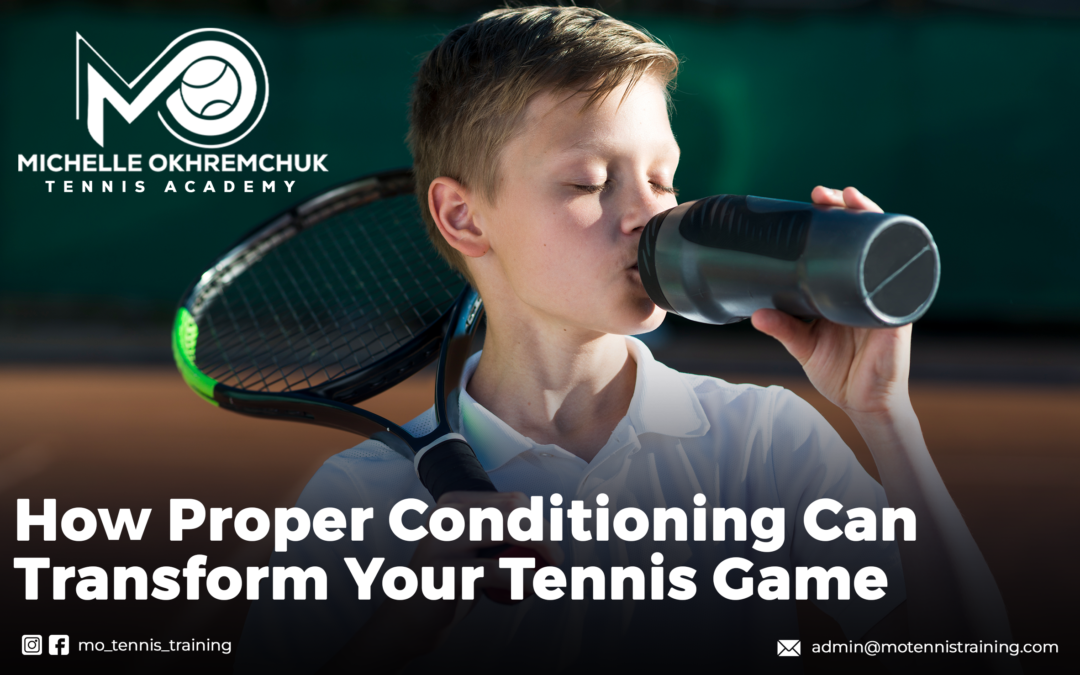Ever watched a professional dominate the court with effortless power and agility? Their secret weapon? It’s not just about fancy strokes or hours spent practicing. Peak performance in tennis hinges on a crucial factor: proper conditioning. This guide discusses the transformative power of conditioning for your tennis game.
We’ll explore a variety of conditioning exercises specifically designed for tennis players, targeting strength, speed, and endurance. You’ll learn how to tailor your training to address weaknesses and improve your skillset. We’ll also unveil the secrets of optimal on-court performance through strategic nutrition and hydration strategies.
But conditioning goes beyond the physical. We’ll explore the importance of mental conditioning, equipping you with the psychological tools to develop a winning mindset. You’ll discover how to manage nerves, maintain focus under pressure, and approach every match with unwavering confidence.
Let’s transform your game, one well-conditioned step at a time!
Different Types of Conditioning Exercises for Tennis Players
When it comes to improving your tennis game, incorporating various conditioning exercises can make a significant difference in your performance on the court.
Strength training is essential for tennis players as it helps build muscle and power, enhancing your ability to generate strong shots and move swiftly across the court. Exercises like squats, lunges, and planks are great for strengthening key muscles used in tennis.
Cardiovascular fitness is crucial for endurance during long matches. Running, cycling, or high-intensity interval training (HIIT) can help improve your stamina and energise you throughout intense rallies.
Agility drills focus on quick movements, sharp direction changes, and hand-eye coordination – all vital skills for successful tennis playing. Incorporating ladder drills, cone drills, and reaction ball exercises can sharpen these abilities.
Flexibility exercises such as yoga or stretching routines can help prevent injuries by increasing joint mobility and reducing muscle stiffness. Maintaining flexibility to move freely around the court without risk of strains or pulls is important.
Nutrition and Hydration Tips for Optimal Performance on the Court
Fueling your body with the right nutrition and staying hydrated are crucial elements for peak performance on the tennis court. As a tennis player, focusing on a well-balanced diet that includes a mix of carbohydrates, proteins, healthy fats, vitamins, and minerals is essential. Carbohydrates provide the energy needed for those quick sprints across the court, while proteins help in muscle repair and recovery.
Stay hydrated before, during, and after your matches or training sessions. Water is key to regulating body temperature and maintaining overall performance levels. Consider incorporating electrolyte-rich beverages for added hydration benefits.
Snack smart by opting for fruits like bananas or berries, which provide natural sugars for quick energy boosts. Nuts or yogurt can be great protein sources to satisfy you throughout your game.
Remember that what you put into your body directly impacts your performance on the court. So make thoughtful choices regarding fueling up before hitting those winning shots!
Mental Conditioning: The Importance of a Strong Mindset in Tennis
In tennis, a strong mindset can make all the difference between victory and defeat. Mental conditioning is just as crucial as physical training for excelling on the court. Michelle Okhremchuk, founder of Mo Tennis Training Academy in San Diego, emphasizes the power of mental resilience in her coaching approach.
Tennis players must train their minds to stay focused, resilient, and positive during intense matches. Their training routines often incorporate visualization techniques, breathing exercises, and mindfulness practices. These help players maintain composure under pressure and bounce back from setbacks.
Developing a strong mindset enhances performance and builds confidence and self-belief. It allows players to adapt quickly to changing circumstances on the court and stay mentally sharp throughout long matches.
Tennis players can unlock their full potential on the court by prioritizing mental conditioning alongside physical workouts and technical skills practice.
Injury Prevention through Proper Conditioning
Injury prevention is crucial for maintaining peak performance on the court. Proper conditioning significantly reduces the risk of injuries that can hinder your game and progress. You can improve your overall physical resilience by incorporating specific exercises targeting strength, flexibility, and balance into your training regimen.
Focus on strengthening key muscle groups such as the core, legs, shoulders, and arms to support your movements during matches. Stretching exercises before and after playing can help enhance flexibility and prevent muscle strains. Working on balance drills will improve stability and reduce the likelihood of falls or awkward landings that could lead to injuries.
Listen to your body and rest when needed to avoid overuse injuries. Adequate recovery time between intense training sessions allows muscles to repair and grow stronger. Remember that injury prevention through proper conditioning is a continuous process that requires dedication on and off the court.
Conclusion
Proper conditioning is essential for any tennis player looking to improve their game. Players can unlock their full potential on the court by incorporating a well-rounded training program that includes physical, nutritional, and mental components.
Whether you are working on improving your strength, speed, agility, or endurance, various conditioning exercises are tailored to suit your needs. Remember to stay hydrated and fuel your body with the right nutrients to maintain peak performance during intense matches.
Don’t underestimate the power of mental conditioning in tennis. Developing a strong mindset will help you stay focused during tough moments and boost your confidence and resilience on the court.
Injury prevention should not be overlooked when it comes to proper conditioning. Incorporating prehab exercises into your routine and listening to your body’s signals can reduce the risk of common tennis-related injuries.
When you prioritize proper conditioning through workouts like those offered at Michelle Okhremchuk’s Mo Tennis Training Academy in San Diego, you can transform your tennis game and reach new heights in your athletic journey.


